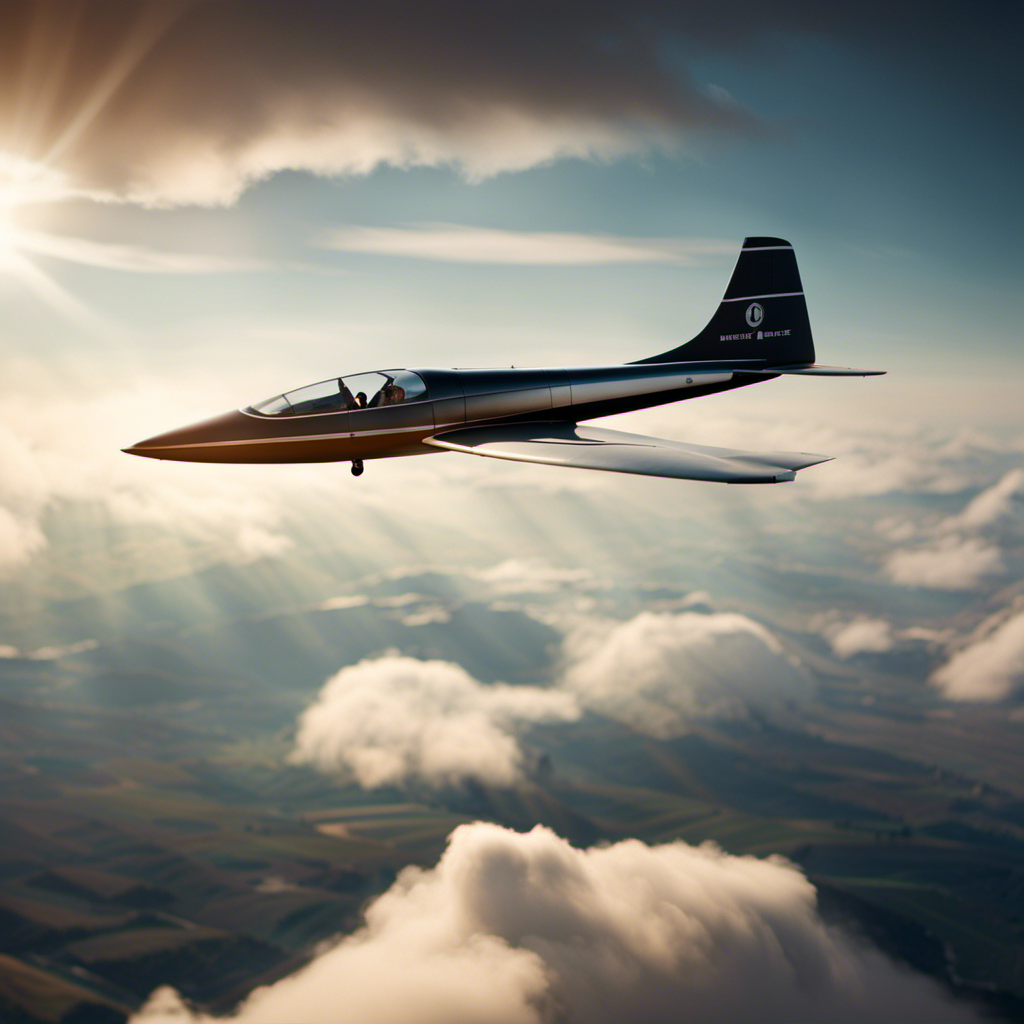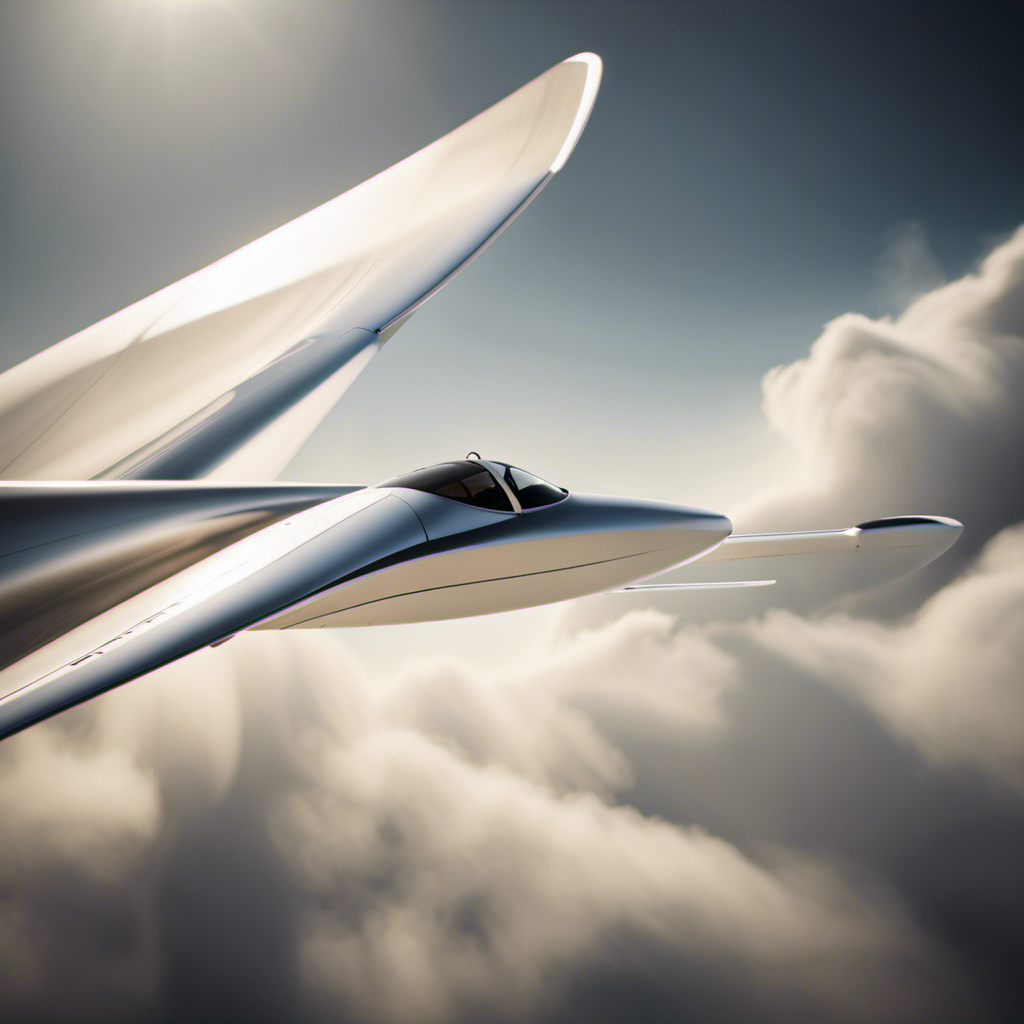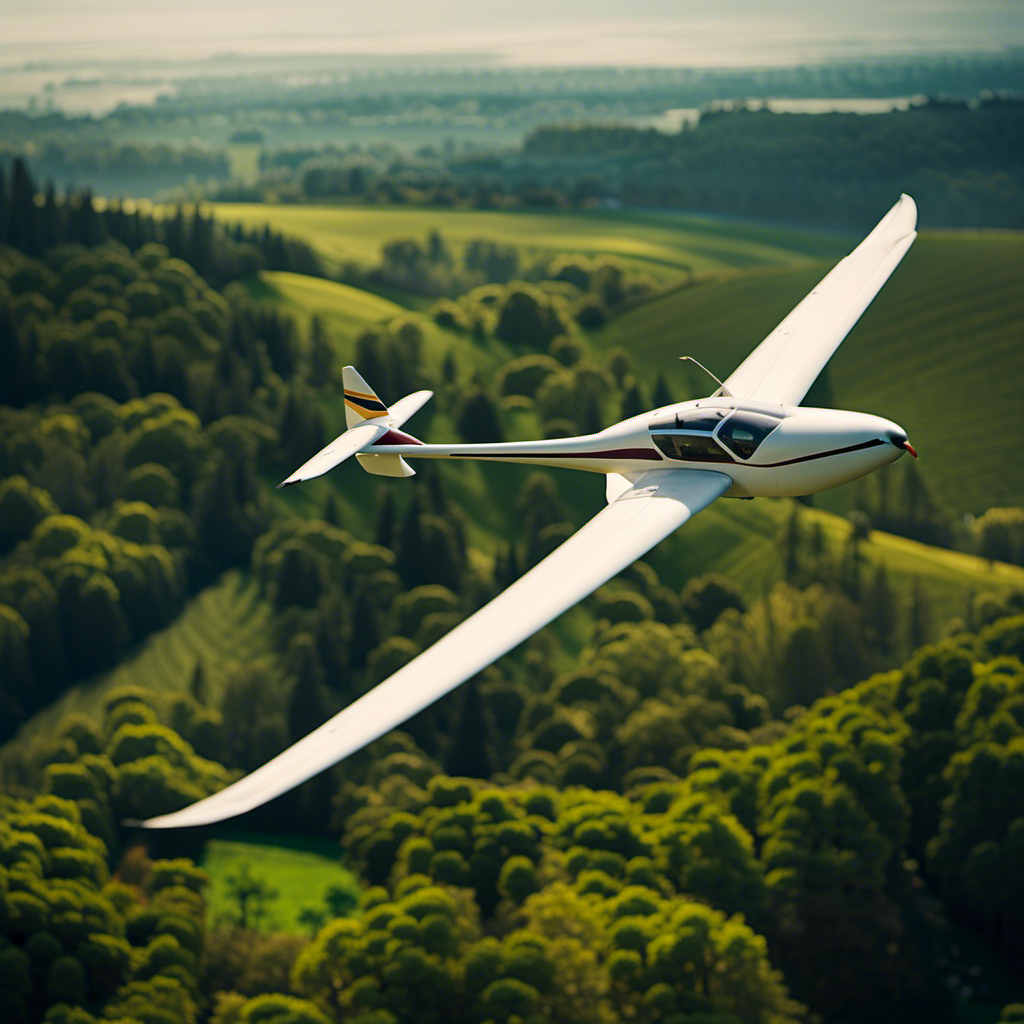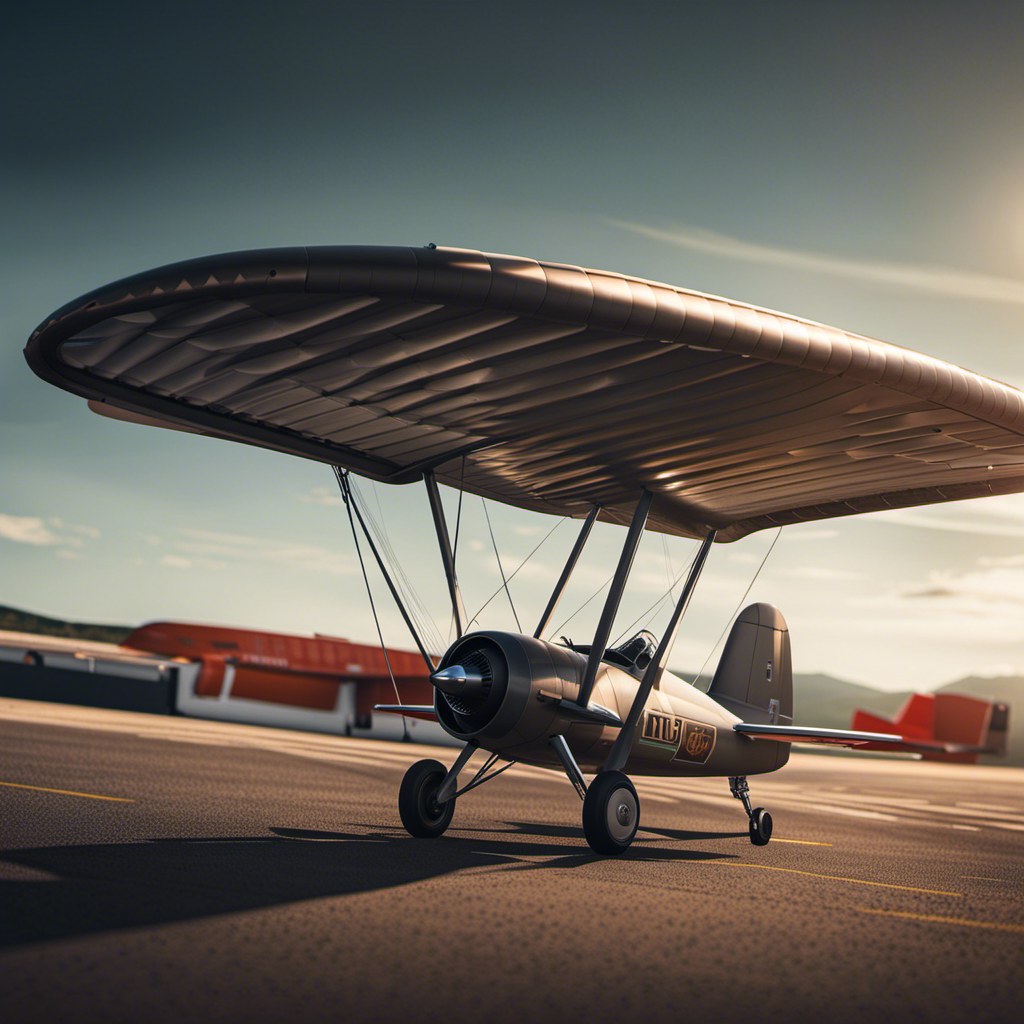As a glider pilot, I often find myself pondering a classic question: How do gliders take off and fly from the ground?
It’s a fascinating process that combines the principles of aerodynamics, gravity, and skillful technique.
In this article, we will delve into the intricacies of glider takeoffs, exploring the role of gravity and the importance of aerodynamics in achieving lift.
We will also examine the various launch methods, such as tow planes and winches, and discuss the necessary pre-flight checks and safety considerations.
So buckle up and prepare for a thrilling journey through the skies of gliding!
Key Takeaways
- Proper weight distribution is crucial for successful glider takeoff.
- Safety considerations, such as conducting pre-flight checks and verifying equipment functionality, are of utmost importance.
- Assessing weather conditions, including wind patterns, visibility, and potential turbulence, is necessary before takeoff.
- Evaluating runway conditions, such as surface quality, length, and availability of emergency landing areas, is essential for a smooth takeoff.
Introduction to Gliders and their Unique Flying Abilities
Gliders are aircraft that can fly without an engine, making them different from conventional airplanes. Unlike powered airplanes, gliders rely on their unique aerodynamic design and the forces of nature to stay airborne.
Glider performance is determined by various factors such as wing design, glide ratio, and weight. These factors allow gliders to achieve impressive flight durations and distances.
Gliding competitions are popular among glider pilots, where they showcase their skills in various tasks such as racing, distance flying, and aerobatics. These competitions not only test the pilots’ abilities but also push the boundaries of glider performance.
Now, let’s delve into the role of gravity in glider takeoffs, where this force plays a crucial part in getting a glider off the ground and into the sky.
The Role of Gravity in Glider Takeoffs
Gravity plays a crucial role in how gliders are able to take flight. When it comes to glider takeoff techniques, harnessing the power of gravity is essential.
To initiate a glider’s takeoff, it is typically towed by another aircraft or launched from a high point such as a hill or a mountain. As the glider gains speed, gravity pulls it downward, converting potential energy into kinetic energy. This acceleration creates lift, allowing the glider to become airborne.
The glider pilot then uses this initial lift to control the aircraft and search for rising air currents or thermals, which further enhance the glider’s performance and allow it to sustain flight without the need for an engine.
Understanding the role of gravity in glider takeoffs sets the stage for delving into the importance of aerodynamics in achieving lift.
The Importance of Aerodynamics in Achieving Lift
Aerodynamics plays a key role in achieving lift, allowing gliders to soar through the air. Without a proper understanding of aerodynamics, gliders would be unable to generate the necessary forces to stay aloft.
Here are three important aspects of aerodynamics in relation to gliders:
-
Bernoulli’s Principle: The faster air flows over the curved upper surface of the glider’s wing, the lower the air pressure becomes. This pressure difference creates lift, allowing the glider to rise.
-
Angle of Attack: The angle at which the glider’s wing meets the oncoming airflow is crucial. A small angle of attack generates less lift, while a large angle of attack can cause the wing to stall and lose lift.
-
Wing Shape: The shape of the glider’s wing, specifically its airfoil profile, determines its lift characteristics. A well-designed airfoil allows the glider to maximize lift while minimizing drag.
Understanding the importance of aerodynamics in achieving lift is essential for comprehending how gliders can take off.
Now, let’s delve into the specifics of glider wings and their shape.
Understanding Glider Wings and Their Shape
Understanding how the shape of a glider’s wing affects its lift and drag is crucial in comprehending the mechanics of flight. Glider wing design plays a significant role in lift generation, which is essential for sustained flight.
The shape of the wing, commonly referred to as the airfoil, determines the lift characteristics of the glider. A typical glider wing has a curved upper surface and a flatter lower surface, creating a pressure difference that generates lift. The camber, or curvature, of the wing helps to optimize lift production.
Additionally, the angle of attack, which is the angle between the wing’s chord line and the oncoming airflow, also affects lift. By understanding these factors, glider designers can create wings that maximize lift while minimizing drag.
Transitioning to the next section, the impact of airspeed on glider takeoffs becomes evident.
The Impact of Airspeed on Glider Takeoffs
To achieve a successful takeoff in a glider, you need to ensure that your airspeed is sufficient for lift to be generated. The impact of air density and the effect of wind speed play crucial roles in determining the necessary airspeed for a glider to take off. Here are three key factors to consider:
-
Air density: High air density provides more lift, allowing the glider to achieve takeoff at a lower airspeed. Conversely, low air density requires a higher airspeed to generate enough lift for takeoff.
-
Wind speed: A headwind increases the effective airspeed of the glider, making it easier to achieve takeoff. Conversely, a tailwind decreases the effective airspeed and may require a longer runway or higher groundspeed.
-
Air temperature: Higher temperatures result in lower air density, requiring a higher airspeed for takeoff. Cooler temperatures increase air density, allowing for takeoff at a lower airspeed.
Understanding these factors and their impact on airspeed is essential for a successful glider takeoff. By maximizing lift in varying air conditions, glider pilots can confidently maneuver their aircraft.
Now let’s explore how to utilize updrafts and thermals for sustained flight.
Utilizing Updrafts and Thermals for Sustained Flight
Utilizing updrafts and thermals can greatly enhance a glider’s ability to stay aloft for an extended period of time. Understanding thermal dynamics is crucial for optimizing glider performance.
Thermals are columns of rising air caused by temperature differences in the atmosphere. When a glider enters a thermal, it gains altitude as it rides the updraft. This allows the glider to fly without the need for an engine, conserving energy and extending flight time. By studying the patterns and characteristics of thermals, glider pilots can effectively navigate and maximize their time in the air.
Transitioning to the topic of launch methods for gliders, including tow planes and winches, gliders rely on external assistance to achieve initial altitude and speed before utilizing updrafts and thermals for sustained flight.
Launch Methods for Gliders, Including Tow Planes and Winches
Gliders can achieve initial altitude and speed through the assistance of tow planes or winches. These launch methods are commonly used when there are no updrafts or thermals available to sustain flight.
However, there are also alternative methods that glider pilots can employ to get their aircraft off the ground. One such method is launching from mountain tops. By taking advantage of the elevated terrain, gliders can be released from a higher altitude, giving them a head start in achieving the necessary speed and lift. This method is particularly popular in regions with mountainous landscapes, where the topography provides an ideal launching point for gliders.
Mastering the skill and technique required for a successful glider takeoff is crucial for pilots to safely and efficiently get their aircraft into the air.
The Skill and Technique Required for a Successful Glider Takeoff
Launching a glider successfully requires skill and technique. It’s not as simple as just pushing it off a hill and hoping for the best. Here are four key factors in achieving a successful glider takeoff:
-
Weight Distribution: Properly distributing the weight is crucial for maintaining balance during takeoff. The center of gravity must be within the prescribed limits to ensure stability.
-
Aerodynamic Control: Skillful manipulation of the control surfaces, such as ailerons and elevators, is necessary to maintain the desired attitude and prevent any unwanted yaw, pitch, or roll.
-
Airspeed Management: Managing the glider’s airspeed is essential for a smooth and controlled takeoff. It requires precise control input to reach and maintain the recommended takeoff speed.
-
Energy Conservation: Applying efficient energy management techniques, such as using thermals or ridge lift, can help maximize the glider’s climb rate and extend its flight duration.
By mastering these skills and techniques, a pilot can achieve a successful glider takeoff.
Now, let’s delve into the crucial safety considerations and pre-flight checks for glider takeoffs.
Safety Considerations and Pre-flight Checks for Glider Takeoffs
Before embarking on a glider flight, it’s important to prioritize safety. This means conducting thorough pre-flight checks and considering various safety considerations.
Safety should always be the top priority when it comes to glider takeoffs. To ensure a safe and successful flight, pilots must perform pre-flight checks. These checks involve assessing the condition of the glider, including inspecting the control surfaces, verifying the integrity of the tow rope, and checking the parachute.
In addition to pre-flight checks, pilots must also consider safety considerations. This includes assessing weather conditions, runway conditions, and airspace restrictions. By thoroughly reviewing these safety considerations and conducting pre-flight checks, pilots can minimize the risk of accidents and ensure a safe takeoff.
With safety measures in place, pilots can then explore the thrill and freedom of gliding through the skies. They can experience the exhilaration of soaring without an engine, knowing that they have taken all necessary precautions to ensure a safe flight.
Exploring the Thrill and Freedom of Gliding through the Skies
To experience the thrill and freedom of gliding through the skies, you’ll feel an incredible sense of exhilaration as you soar without an engine. Gliding is not just a recreational activity, but also a competitive sport. Glider competitions are held worldwide, where pilots showcase their skills in various disciplines such as aerobatics, distance flying, and speed races. These events push the boundaries of gliding technology and encourage innovation in the field. The future of gliding technology looks promising, with advancements in materials, aerodynamics, and navigation systems. Pilots are constantly exploring new techniques and strategies to gain an edge over their competitors. The table below provides a snapshot of the different glider competitions and the future technologies that are being developed to enhance the gliding experience.
| Competition | Description |
|---|---|
| Aerobatics | Pilots perform intricate maneuvers and stunts |
| Distance Flying | Covering long distances with limited energy |
| Speed Races | Competing to complete a course in the shortest time |
| Future Gliding Technology | Description |
|---|---|
| Advanced Materials | Lighter and stronger materials for improved performance |
| Enhanced Aerodynamics | Streamlined designs to reduce drag and increase efficiency |
| Navigation Systems | Advanced GPS and avionics for precise navigation and route planning |
As gliding continues to evolve, these advancements will shape the future of the sport, allowing pilots to push the boundaries of what is possible in the world of gliding.
Frequently Asked Questions
Are gliders able to take off from any type of terrain or surface?
Glider takeoff techniques vary depending on terrain and surface. Safety precautions must be taken into account when considering takeoff. Factors such as wind speed, runway length, and slope are important considerations for a successful and safe glider takeoff.
Can gliders take off and land at night?
During nighttime operations, gliders can take off and land safely with the help of specialized lighting systems and strict safety measures. It is essential to ensure proper visibility and follow guidelines to mitigate risks associated with reduced visibility.
What is the maximum distance a glider can travel without the use of external assistance?
Without external assistance, a glider can travel a maximum distance determined by its maximum altitude, the availability of thermals and updrafts. These natural phenomena provide the necessary lift for sustained flight and enable gliders to cover great distances.
Is it possible for a glider to take off and land vertically?
No, it is not possible for a glider to take off and land vertically. Gliders rely on external assistance, such as being towed by a powered aircraft or being launched from a winch or a bungee cord, to gain enough speed for takeoff. Once airborne, gliders use various landing techniques to safely return to the ground.
Are there any age restrictions for piloting a glider?
Yes, there are age restrictions for piloting a glider. The minimum age to fly a glider solo varies by country, but it is typically around 14-16 years old. Training and certifications are required.
Conclusion
In conclusion, gliders are unique aircraft that rely on gravity, aerodynamics, and airspeed to take off and soar through the skies. The shape of glider wings and the skill of the pilot play crucial roles in achieving lift.
Whether launched by tow planes or winches, a successful glider takeoff requires precision and technique. Safety considerations and pre-flight checks are essential to ensure a smooth and thrilling gliding experience.
So why wait? Embrace the freedom of gliding and let your spirit soar in the vast expanse of the heavens.
With a heart that soars as high as the skies, Aria, affectionately known as “Skylark,” is the driving force behind Soaring Skyways. Her journey into the gliding world began as a young dreamer gazing up at the soaring birds, yearning to experience the weightlessness and freedom they embodied. With years of experience both in the cockpit and behind the scenes, Aria’s commitment to the gliding community is unwavering.










